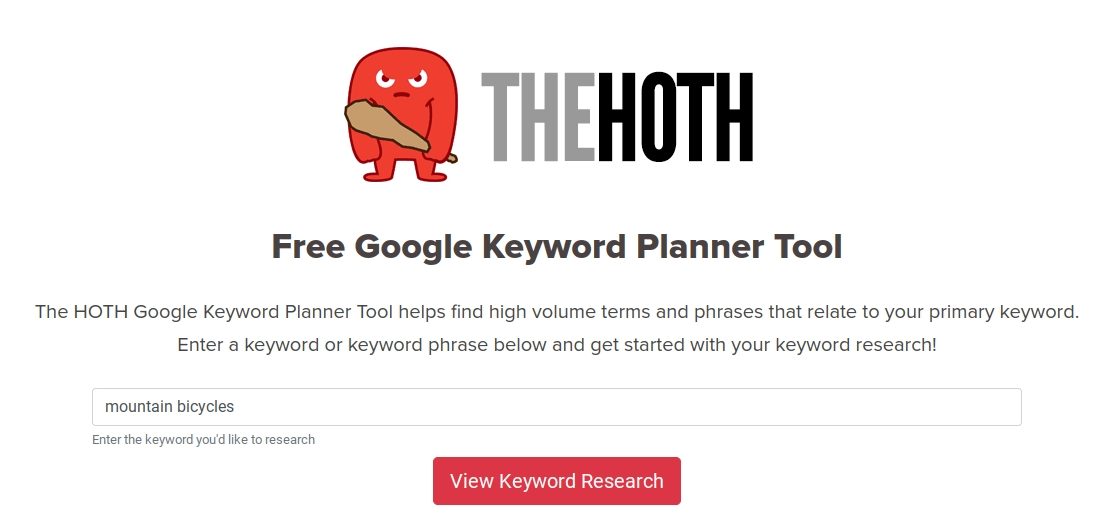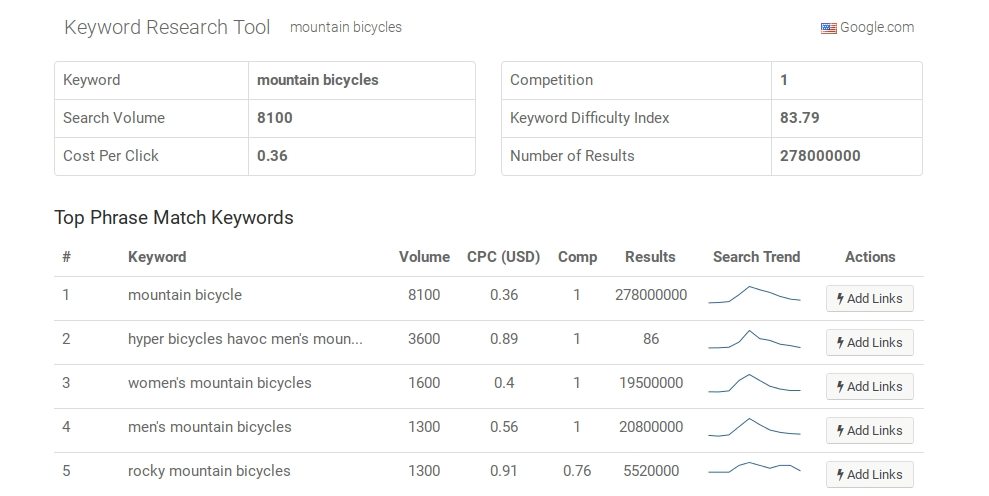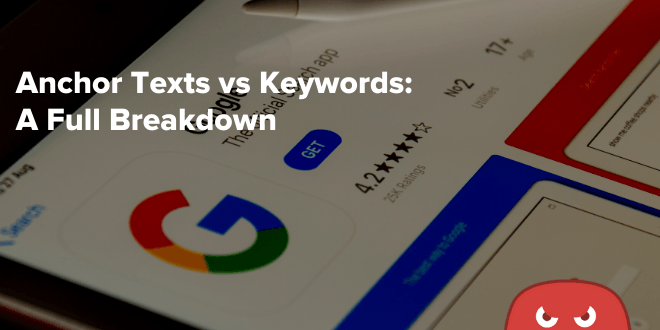Quick Links
One of the first questions new clients ask us is the difference between anchor text and keywords. Aren’t they the same thing? No, not exactly.
They seem similar, and both appear in your content, yet there is a substantial difference between the two. Not understanding how anchor text and keywords each work could result in your site falling down the search engine results pages (SERPs), or worst case, a penalty.
We’re going to talk about anchor text and SEO and break down the difference between anchor text and keywords. Let’s get into it!
Keywords vs. Anchor Text
Keywords are words or short phrases that many people are searching for online. Some of the most popular keywords on Google include “weather,” “internet speed test,” and “restaurants near me.”
There are literally thousands of keywords for any one topic, and some are more competitive than others. SEO professionals rank their competitiveness according to keyword difficulty or KD. The super hard keywords are some of the most coveted by websites.
Like keywords, anchor texts are short phrases in your content. The difference is anchor text is hyperlinked to another page or site. Internal and external links are a big part of effective SEO.
Both keywords and anchor texts can boost your online ranking when used correctly.
The Relationship Between Anchor Text and SEO
Anchor text is one of the vital factors that will determine the viability of your website and significantly affect your SEO efforts. It’s not the end-all and be-all to Google ranking but is one of the more important ranking factors. Anchor text affects SEO significantly because it tells your reader where they can find information that’s relevant to their search, something Google takes very seriously.
Do Keywords and Anchor Text Carry the Same Weight in Google?
While it’s difficult to determine the exact weight anchor text and keywords carry as Google constantly changes its algorithms, most believe that anchor text and keywords carry similar weight in terms of ranking and SEO.
Some believe that anchor text carries even more weight than keywords as they can influence Google’s understanding of what a webpage is about. Indeed, more than a few websites have ad their topic changed by Google’s algorithms based on the anchor text they used.
The biggest difference, of course, is that anchor text is used in links that take a reader to another page on your website or another site entirely. Keywords are the words that consumers type into their browser to find a website initially.
Why is Anchor Text Important to SEO?
Like keywords, anchor text is vital to the success of any website and significantly improves a website’s SEO.
At their core, anchor text guides visitors reading content on your website to information that they might find useful, helpful, or pertinent to their search. Maybe, more importantly, the anchor text you use tells the reader what they can expect, more or less, when they click the text and are taken to the webpage it links to.
As with keywords, you shouldn’t take anchor text lightly. It’s essential you pay close attention to the anchor texts you’re using and use a variety of them rather than the same anchor text for every link.
Not only are the words in your anchor text vitally important, but the surrounding words are also, as the combination is what will either convince a reader to click the link or skip over it.
Anchor text also tells Google everything they need to know about the content of your content. This factor is important because, using their many algorithms, Google will determine what your webpage is about and rank it accordingly.
Lastly, it’s critical that you only link to web pages that are relevant to the original content and search and link to reputable pages. Using anchor text to link to spam, scam, or otherwise negative websites is never a good idea. (More on this further down.)
What are the Different Types of Anchor Text?
There are several different types of anchor text that can and should, be used in all of your content (some much more than others). Below we’ll take a quick look at all of them to give you a better idea of what they mean and why you should use (or not use) them. All of them, if used correctly, will improve and optimize your SEO and your rank on all search engines, especially Google.
Exact match
As the name suggests, exact match anchor text uses the exact keywords or key phrases that make sense for your website, business, and SEO goals.
For example, let’s say big-box superstore Target is selling silk ties for men. An excellent example of an exact match anchor text advertising those ties would be “men’s silk ties,” and another would be “silk ties for men.”
Here’s another example. In this one, you’re writing content for your self-storage center in Atlanta, Georgia. In this situation, excellent exact match anchor texts could include “Atlanta self-storage center,” “self-storage center, Atlanta,” or “Self-storage, Atlanta.”
In short, an exact match anchor text exactly matches the product, service, idea, etc., that you’re linking to, with no extra keywords and no fluff. Note that exact match anchor text is often referred to as “phrase match” anchor text.
Partial match
Partial match anchor text is any anchor text that includes partial keywords and phrases plus several other words used together in the same link. In short, it’s not exact, but it’s pretty close.
Using the same two examples from earlier, an excellent partial match anchor text for Target and their men’s silk ties would be “How to buy a man a silk tie,” “Where to find men’s silk ties,” or “The best silk ties for men.”
If we use the 2nd example for the self-storage center in Atlanta, some well-written partial match anchor texts you could use would be “Safe, clean storage units in Atlanta,” “How to find Atlanta self-storage locations,” or “ Where to store your stuff in Atlanta.”
Partial match anchor text will take you to the same web page as an exact match but allows you to use various words that a potential visitor, customer, or client might use to search for what you have to offer.
By the way, partial match anchors and partial match anchor words are the same as partial match anchor text. (If you see these terms, you’ll know what the author is talking about.)
Branded
Branded anchor text uses the exact brand name of a company, product, service, etc. Using our examples, “Target” would be the brand anchor text used for Target, the big-box retailer. For our Atlanta self-storage center, “iStorage” would be the branded anchor text.
Naked URL
While not the best for driving visitors to your website or online content, naked link anchor text can be useful. Also, Google seems to love them as the chance of naked anchor text being spam is much lower. Using our previous examples, a naked link anchor for Target would be https://www.target.com/, while one for our self-storage center in Atlanta would be https://www.istorage.com/.
Basically, a naked link anchor text consists of the protocol plus the domain address (i.e., the complete URL) for a website’s page.
Note that some consider branded anchor text and naked link (URL) anchor text to be almost identical. However, the difference is that the former uses the company’s proper name, website, etc., while the latter uses the brand’s URL.
Generic (Random)
Many people confuse generic anchor text with naked anchor text, but, as you’ll see, they are quite different.
Generic anchor text features words, although they aren’t keywords. However, as you might have guessed, the words are random or generic and have no connection to the product, service, or information being offered. Naked anchor text, as we saw above, is simply the URL for a web page. (Big difference, yes?)
An example of a generic link for Target’s ties for men would thus be; To learn more about our trendy men’s silk ties, “Click Here.” For our storage center example, you could use the same “Click here” and the also generic “See More.” A few other generic anchor text examples include “More Information” and “Vist our webpage.” “Read more” and the incredibly generic “website.”
One important thing to note is that when using generic anchor text, the regular text surrounding it must give the reader a solid idea of what they will get if they click the link.
If the surrounding text doesn’t do that or does it poorly, the reader may be confused, which is the last thing you want when creating online content.
Here’s a good example using the Atlanta self-storage center from earlier. “If you’d like to learn more about storing your household goods in Atlanta, Georgia, click here.”
A poor example would look something like this: “Thank you for visiting our website today. Please click here for more.” Some readers might see that and ask themselves, “For more what, exactly?”
Related
Related anchor text is similar to partial match anchor text minus a precise keyword phrase.
Typically, related anchor text uses a variation of the wanted target keywords. A good example of related anchor text for our Target silk ties would be “trendy men’s fashion tips” or “must-have men’s clothing accessories.”
Our Atlanta self-storage center could use a related anchor text like “How to store a car” or “long-term wine storage.” Related anchor text helps Google decide what your link is relating to and will also keep your link profile noticeable different from others. That way, it won’t get dinged as spam.
What is an Image Anchor?
An image anchor is when you use an image as a link to another internal or external webpage. It’s similar to anchor text, but you use a picture, photo, drawing, or some other type of image instead of text.
Many businesses use image anchors to help visitors navigate their website, and they are most commonly used for internal rather than external linking.
Many image anchors are similar to a clickable ad you’ll see when surfing the web, and many have a call to action (CTA) that encourages the visitor to click them and go the linked webpage. Also, image anchors are an excellent method of varying your anchor texts, even if they are a bit non-traditional.
When using image anchors, one thing to keep in mind is that they have a nasty habit of making a website less accessible to visitors.
For example, in many instances, a visitor will be trying to resize the page to better see what they’re reading. However, doing so with an image anchor can move them around against their wishes, which can be frustrating and cause them to click away.
Optimizing Your SEO With Keywords
SEO professionals spend a lot of time researching keywords. They use software and online tools to help find relevant keywords that have a high search volume and are more likely to end in conversions.
Free tools like The HOTH’s Keyword Planner can help you explore keywords without signing up for an expensive service.

You can search for specific keywords relevant to your business. As you can see below, it will tell you the search volume, keyword difficulty, and the cost per click (CPC) for any ad campaign.

Once you compile a list of effective keywords, your next step is to include them on your site. You should add them to titles, descriptions, headings, meta tags, and throughout web copy.
Google will then index your pages and begin to rank your website by matching your keywords with what people are searching for online.
Optimizing Your SEO With Keywords
SEO professionals spend a lot of time researching keywords. They use software and online tools to help find relevant keywords that have a high search volume and are more likely to end in conversions.
Free tools like the HOTH’s Keyword Planner can help you explore keywords without signing up for an expensive service.
You can search for specific keywords relevant to your business. As you can see below, it will tell you the search volume, keyword difficulty, and the cost per click (CPC) for any ad campaign.
Once you compile a list of effective keywords, your next step is to include them on your site. They should be added to titles, descriptions, headings, meta tags, and throughout web copy.
Google will then index your pages and begin to rank your website by matching your keywords with what people are searching for online.
Best Practices for Anchor Text and SEO
As we pointed out above, anchor text is used for links while keywords are used to optimize your website ranking on Google. There are two types of links: internal links that drive visitors to another page on your site and external links that send visitors to another site on the web.
Backlinks (when another site has a link to one of your pages) are one of the most effective ways to boost your website ranking.
Here is a description of anchor texts from our link building online guide.

By now, you’ve probably noticed that this article has anchor texts. You’re learning fast!
Our guest post product can help clients obtain more links by using blogger outreach and anchor text.
Can keywords be used as anchor text?
Yes, but beware because doing that too much could potentially harm your SEO. No perfect anchor text ratio currently exists. Rather you should keep your anchor texts diverse. There are six anchor text categories to choose from, all of which we described in detail (above):
- Using the exact keyword
- A variation of the exact keyword
- Listing a naked URL like http://www.thehoth.com
- Hyperlinking a brand name
- Using benign anchor texts like “click here.”
- Linking only an image
Online tools like Ahrefs allow you to look up all of your links and see whether you’re using all six equally. It’s better to be safe than sorry.
More Best Practices for Using Anchor Text to Optimize your Website
Now that you have a much better idea of what an anchor text is and the different types of anchor text let’s take a closer look at the best (and not so good) methods of using anchor text in its various forms.
Ensure your anchor text adds value for the reader
When building and optimizing a website, you need to realize that, in Google’s eyes, every single thing is important. That includes written content, images, keywords, links, and the anchor text used in those links.
The worst thing you can do on a website is use content that provides no value to the reader, including the words you use for your anchor text.
Also, anchor text needs to be placed where it makes the most sense. Lacing random links throughout your content might seem like a great idea, but to Google, it’s a cardinal sin.
Avoid overuse of anchor text to optimize your SEO
Anchor text and the web pages they link to are essential for any website, whether those links are internal or external. However, too many links and too much anchor text will be flagged by Google as spam as, in their eyes, it’s a gross manipulation of the practice.
Another no-no is using the same anchor text repeatedly, which means that you need to use various anchor text combinations.
Referring back to our earlier example of the Atlanta self-storage center, if you constantly use the anchor text “Atlanta self-storage center,” Google will often penalize you. Instead, use a variety of anchor text. “Safe self-storage in Atlanta,” for example, “What to look for in a self-storage center,” or “Is Atlanta self-storage affordable?”
Place anchor text accordingly when link building
Today, many people skim web pages rather than starting at the beginning and reading every last word. When they do, they typically look for headings and subheadings, including H2, H3, etc., to guide them, reading more when they see a header that interests them.
For this reason, placing your anchor text and links near your site’s “hot spots,” if you will, is a good call. This technique is more psychological than a specific formula, though, and changes from one website visitor or reader to the next.
Use relevant anchor text when link building
Here’s the thing about Google; they are very obsessive about always providing a better user experience to the folks using their search engine. They love it when your anchor text is relevant to your website and also when it links to relevant information.
The opposite is also true, as Google despises non-relevant anchor text that leads the reader to non-relevant web pages and content.
Even if you place a non-relevant anchor text that links to your own website, Google will often flag you, which can severely damage your SEO and ranking on their search engine.
Use a good combination of anchor text styles to optimize your SEO
One critical best practice when using anchor text is distributing them in the correct proportion on your website.
Unfortunately, there’s no “right” way to distribute anchor text but there are abortions that, generally, are acceptable. The HOTH recommends using anchor text in the following proportions to optimize your SEO:
- Branded anchor text- 50%
- Naked Link Anchor Text- 20%
- Website page title- 20%
- Generic / Random anchor text- 2-5%
- Exact anchor text- 2-5%
- Partial match anchor text- 2-5%
Beginner Tips for Better SEO
Understanding the difference between keywords and anchor text is only the first step on the road to better SEO and higher rankings on Google and other search engines. You need to start creating more content on your site that includes both of these essential items.
For example, create content that answers frequent questions asked by your customers, and includes your keywords and anchor text. Not only will this be helpful for them to read (meaning better customer service ratings), but it’ll also boost your SEO and optimize your ranking.
Don’t worry about creating more than one page for a product or group of products. When it comes to product pages, a best practice is to build one page to rank for one keyword. Having too many keywords on one page could confuse the Google algorithm.
Start Growing Your SEO This Year!
We hope you better understand keywords and anchor text after reading this article. They are the foundation of good SEO. It’s important to be familiar with both terms, whether you’re optimizing on your own or working with an agency.
Suppose you don’t have the time, skills, or interest to work on your digital marketing. In that case, you should consider a managed service like HOTH X. Our enrolled clients work with a dedicated campaign manager and have access to all of our products: web copy, blogging, link building, and more.
Want to chat with us about your goals? Schedule a call, and we’ll offer you recommendations on the best services to improve your online business.









Great Post! I have been experimenting with anchor texts distribution for myself and my clients for a while now and I have roughly created a percentage ratio, mentioning it below. Let me know what you think about it. 🙂
50% exact match
20% partial match (other keywords from the KW family)
10% Branded anchors
10% naked URLs
10% generic
Although it varies for every project and totally depends on the competitive requirements, working on this anchor ratio strategy has worked quite well for me.
Thanks for sharing 🙂
great post thank you for sharing this !
Thank you for sharing this. It is important to always ensure that anchor texts proportions are properly used otherwise it can appear spammy to Search Engines.
Check out the comment above – signed by “keyword Research” lol
Thanks